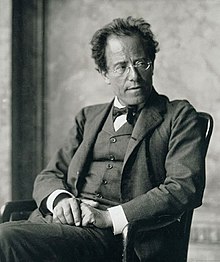 Gustav Mahler (July 7, 1860 – May 18, 1911)
Gustav Mahler (July 7, 1860 – May 18, 1911)
Gustav Mahler composed nine symphonies and began his tenth. His Symphony No. 9 was completed in April, 1910, one year before his death, and premiered June, 1912, one year after. With ahistorical hindsight, many have regarded the 9th as a summation of the composer’s life and a farewell to life and music. This is faulty history and a bad way to hear the complex, astonishing music. In the course of this ninety minute symphony, one may hear myriad forces of nature, human experience, and the poignant, irregular pulse in the music. There are pauses; floods of sweeping phrases; galumphing, country dances; a final, transcendent adagio. The movements end as though falling apart, with a harsh punch, or evaporate into another form of being. This writer has heard it said the Mahler’s Symphony No. 9 is not the most sought after for performance. It happens in multiple dimensions at once. It cannot be summed up — it is not “the one with a thousand voices”–it is music made of Mahler’s measureless understanding of music. In the few years preceding his death, Mahler’s life was full of events. He resigned from a ten year tenure as the Artistic Director of the Vienna Court Opera, a role in which he and the orchestra flourished despite constant difficulties, not least the anti-Semitic attacks on Mahler. He desired more time for composing. His four year old daughter, Maria, died. Within days of her death, Mahler learned he had a severe heart problem and needed to curb his activities. An energetic outdoorsman, hiker, swimmer, Mahler was forced to limit the athleticism he loved. This was not a time of giving up: he became Director of the New York Philharmonic and composed Das Lied von der Erde. He continued to lead a life of creative accomplishment and leadership given to large institutions. He was not an artist in retirement or an invalid marking time. Having seen tv dramas in which someone plays more than one chess game simultaneously, and having tried but not pursued playing even one chess game at a time, one could imagine an unusual person succeeding at that but could not guess how . The structure of Mahler’s Symphony No. 9 has a multi-layered complexity put together in a way that creates a unified beauty. It encompasses human emotions and the endless fascination of the natural world. To know one flower, one must look closely and also envision the earth.
 Michael Tilson Thomas, Music Director of San Francisco Symphony
Michael Tilson Thomas, Music Director of San Francisco Symphony
Michael Tilson Thomas conducted the superb, mind-opening, heart-tearing performances of Mahler’s Symphony No. 9, June 13-16, 2019. The Hedgehogs attended the June 16th concert which will be Maestro Tilson Thomas’ last performance with the SFS until his return on September 4. He is taking a leave to have heart surgery, in Cleveland. He was to conduct the Symphony’s programs programs June 20-22 and June 27-30. His composition, Street Song for Symphonic Brass, on the program for June 20-22, will not be performed. His devoted following, truly a chorus of thousands, wish him well and await his return.